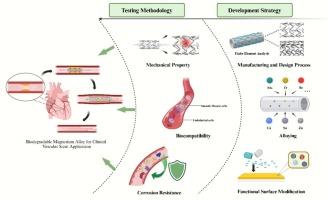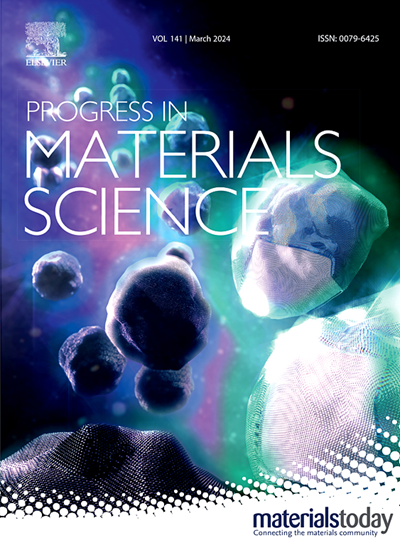In vitro assays and development strategies for magnesium-based biodegradable cardiovascular stent: A decade of review
IF 40
1区 材料科学
Q1 MATERIALS SCIENCE, MULTIDISCIPLINARY
引用次数: 0
Abstract
Cardiovascular disease (CVD) remains a leading global cause of mortality, underscoring the urgent need for innovative therapeutic solutions. Biodegradable magnesium-based stents (BMgS) have emerged as groundbreaking alternatives for coronary artery disease, offering temporary vascular support with safe biodegradation to minimize complications associated with permanent implants. Over the past decade, significant strides have been made in BMgS research, particularly in material science, advanced manufacturing techniques, and surface modifications. However, challenges such as uncontrolled degradation rates, insufficient mechanical strength, and limited biocompatibility continue to hinder their clinical adoption. This review provides a comprehensive and critical analysis of BMgS development advancements, with a particular focus on in vitro testing methodologies. Core areas include corrosion performance evaluation, mechanical property testing, and biocompatibility assessments, highlighting innovative approaches such as novel corrosion reactors, finite element analysis (FEA), and advanced biological assays. Development strategies center on alloy optimization (Mg-Zn and Mg-RE systems), cutting-edge manufacturing processes, and sophisticated surface modifications, including polymer, inorganic, and composite coatings, all tailored to enhance stent functionality. By synthesizing recent progress, this review not only identifies persistent challenges but also provides actionable insights for overcoming them. These findings serve as a valuable resource for researchers and industry stakeholders, paving the way for next-generation BMgS that strive to revolutionize cardiovascular care and improve patient outcomes.


镁基可生物降解心血管支架的体外检测和发展策略:十年回顾
心血管疾病(CVD)仍然是全球主要的死亡原因,强调迫切需要创新的治疗解决方案。可生物降解镁基支架(bmg)已成为冠状动脉疾病的突破性替代方案,提供安全的生物降解临时血管支持,以减少永久性植入物相关的并发症。在过去的十年中,bmg的研究取得了重大进展,特别是在材料科学、先进制造技术和表面改性方面。然而,诸如不受控制的降解率、机械强度不足和有限的生物相容性等挑战继续阻碍着它们的临床应用。这篇综述对bmg的发展进展进行了全面和批判性的分析,特别关注体外测试方法。核心领域包括腐蚀性能评估、机械性能测试和生物相容性评估,突出创新方法,如新型腐蚀反应器、有限元分析(FEA)和先进的生物分析。开发战略的核心是合金优化(Mg-Zn和Mg-RE系统)、尖端制造工艺和复杂的表面改性,包括聚合物、无机和复合涂层,所有这些都是为了增强支架功能而量身定制的。通过综合最近的进展,本综述不仅确定了持续存在的挑战,而且为克服这些挑战提供了可行的见解。这些发现为研究人员和行业利益相关者提供了宝贵的资源,为下一代bmg铺平了道路,努力改变心血管护理和改善患者预后。
本文章由计算机程序翻译,如有差异,请以英文原文为准。
求助全文
约1分钟内获得全文
求助全文
来源期刊

Progress in Materials Science
工程技术-材料科学:综合
CiteScore
59.60
自引率
0.80%
发文量
101
审稿时长
11.4 months
期刊介绍:
Progress in Materials Science is a journal that publishes authoritative and critical reviews of recent advances in the science of materials. The focus of the journal is on the fundamental aspects of materials science, particularly those concerning microstructure and nanostructure and their relationship to properties. Emphasis is also placed on the thermodynamics, kinetics, mechanisms, and modeling of processes within materials, as well as the understanding of material properties in engineering and other applications.
The journal welcomes reviews from authors who are active leaders in the field of materials science and have a strong scientific track record. Materials of interest include metallic, ceramic, polymeric, biological, medical, and composite materials in all forms.
Manuscripts submitted to Progress in Materials Science are generally longer than those found in other research journals. While the focus is on invited reviews, interested authors may submit a proposal for consideration. Non-invited manuscripts are required to be preceded by the submission of a proposal. Authors publishing in Progress in Materials Science have the option to publish their research via subscription or open access. Open access publication requires the author or research funder to meet a publication fee (APC).
Abstracting and indexing services for Progress in Materials Science include Current Contents, Science Citation Index Expanded, Materials Science Citation Index, Chemical Abstracts, Engineering Index, INSPEC, and Scopus.
 求助内容:
求助内容: 应助结果提醒方式:
应助结果提醒方式:


